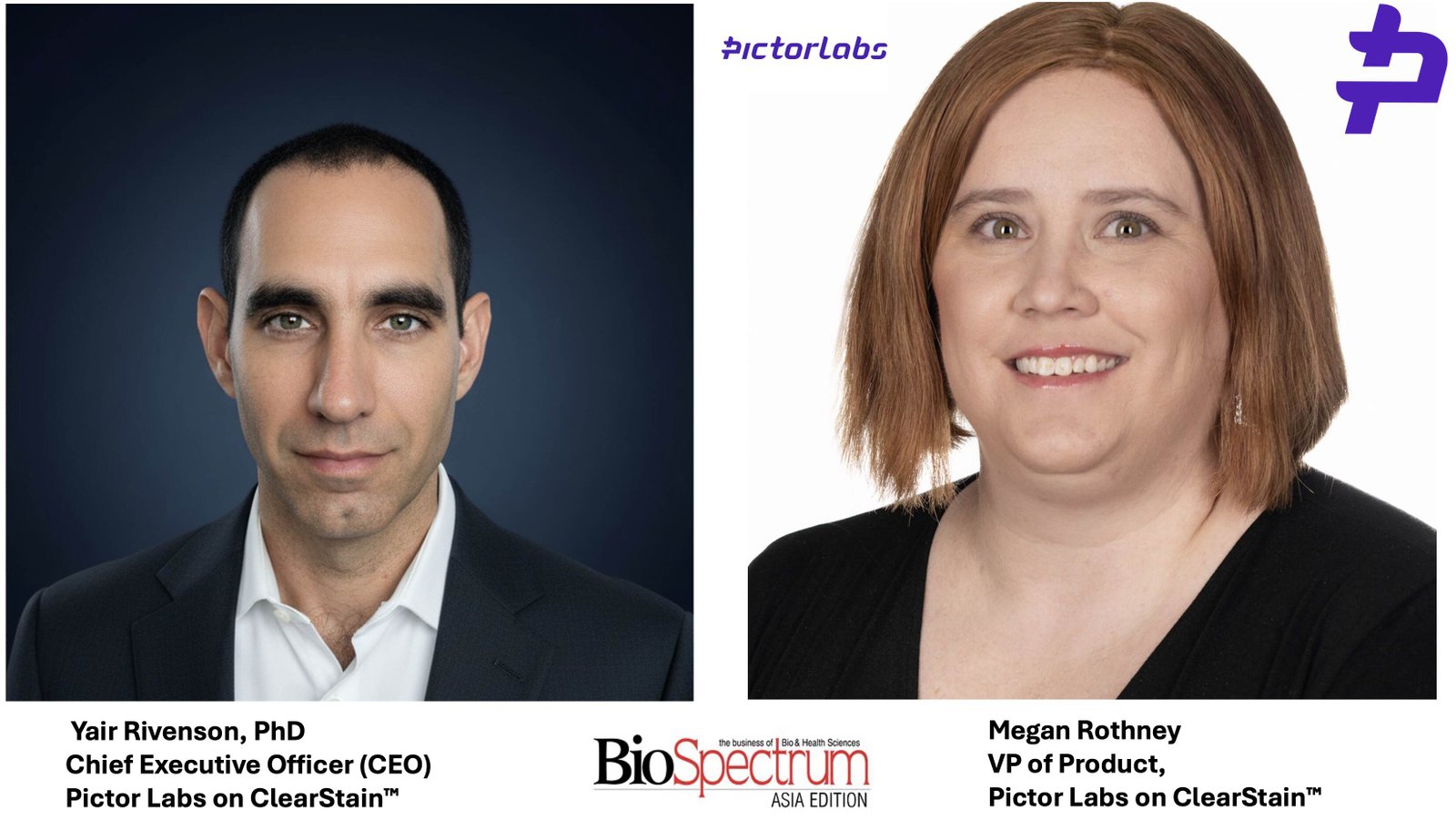AI Powered ClearStain Advances the Next Era of Digital Pathology
November 12, 2025 | Wednesday | News | By Ankit Kankar | ankit.kankar@mmactiv.com
Dr Yair Rivenson, Chief Executive Officer and Co-Founder, and Megan Rothney, Vice President of Product at Pictor Labs, explain how ClearStain uses artificial intelligence to transform unstained tissue into vivid H&E images, bridging histology and molecular sequencing to advance precision oncology.
Artificial intelligence is rewriting the language of pathology, and Pictor Labs stands firmly at the frontier. With ClearStain™, the company introduces an AI-driven virtual staining platform that converts unstained tissue slides into lifelike H&E images—preserving valuable samples for downstream molecular analysis. In this exclusive Q&A, BioSpectrum Asia speaks with Dr Yair Rivenson, Chief Executive Officer and Co-Founder, and Megan Rothney, Vice President of Product at Pictor Labs, to explore how ClearStain™ bridges traditional histology and next-generation sequencing, shortens turnaround times, and strengthens the foundation of precision oncology.
ClearStain™ represents a major leap in digital pathology. Could you describe the science and innovation behind this AI-powered virtual staining platform, and how it compares with traditional histological staining?
Answer (Yair): H&E is a foundational tool in pathology – it’s the first stain that is ordered on every slide and is used to find cancer, regions of tissue death, inflammation, and other important characteristics. But, the chemicals used to create the stain are permanent and once applied, that tissue cannot be used for any other activities, such as molecular testing. ClearStain™ allows an unstained slide to be transformed into an H&E image that looks visually comparable to a traditional, chemical stain. The product uses AI to identify contrast in the tissue that is difficult to see with the naked eye. The algorithm then uses this information to render H&E image of the microstructural contrast that allows pathologists to identify regions more useful for macrodissection and inclusion in molecular analysis without sacrificing precious tissue. Pathologists compared tissues and tumors visualized with ClearStain™ to traditional chemically stained slides and found them visually comparable in 99-100% of regions reviewed.
What specific challenges in tissue sequencing and molecular pathology does ClearStain™ address—particularly regarding tumour purity, turnaround time, and sequencing failure rates?
Answer (Megan): In current workflows, when a lab wants to identify an area of tumor on a slide for sequencing they perform a chemical H&E on representative slides, usually the first and last slide. They use these slides to approximate where there is tumor tissue on all the other slides. Not only have they rendered these two slides unusable for macrodissection, but they have incomplete information about areas of tumor which can drift between serial slides. Many labs we have talked to indicate that the tumor area only remains stable in 20-30% of cases. In the remaining 70-80% of cases, the means that dissecting based on the first and last slide may lead to inclusion of areas of necrosis, fibrosis, inflammation, and normal tissue in samples selected for nucleic acid purification. This means the lab may not have enough nucleic acid to perform sequencing, and the sample they have may contain impurities that make it harder to get accurate sequencing results. ClearStain™ creates an H&E image on each slide so that macrodissection can be correctly guided on each slide. The process may also shorten turnaround time by simplifying review and tumor annotation, while preserving all physical slides for downstream use, reducing failure rates and maximizing sample utility.
The platform bridges the gap between histology and molecular sequencing. How does this integration enhance precision oncology workflows in both research and clinical settings?
Answer (Megan): Precision oncology requires the use of advanced molecular analysis. ClearStain™ enhances this precision medicine workflow by allowing sequencing to be performed on more tumor-rich and relevant regions leading to accurate results from more samples. This should increase the likelihood of a research discovery, and reduce failed runs. ClearStain™ preserves precious tissue that would otherwise be consumed by chemical staining; it enables sequencing or additional downstream testing for specimens with limited tumor material. This means that more researchers, and ultimately more patients have the potential to benefit from precision oncology
From an adoption perspective, how do you see molecular labs and biopharma partners integrating ClearStain™ into existing sequencing pipelines? Are there early collaborators or pilots that demonstrate its real-world impact?
Answer (Yair): When utilizing ClearStain™, one of the core benefits is its ability to integrate seamlessly into existing sequencing workflows. By optimizing tissue imaging compatibility, ClearStain™ reduces signal interference and preserves molecular integrity—unlocking higher-quality NGS data without requiring major workflow adjustments. There has been significant enthusiasm from both biopharma and molecular pathology communities regarding ClearStain™. Early pilot collaborations are planned to evaluate its performance in real-world sequencing pipelines in 2026. These efforts will help quantify ClearStain™’s impact across diverse laboratory environments and use cases.
AI models are often judged by transparency and reproducibility. How does Pictor Labs ensure that ClearStain™ maintains interpretability, regulatory alignment, and data integrity across global markets?
Answer (Megan): To demonstrate the validity of ClearStain™, like other Pictor Labs products, we are able to compare our result to a chemical H&E on the same tissue slide used to produce the virtual H&E. This allows pathologists to see how the model is performing relative to the chemical stain. Using ClearStain™, we are also able to compare the slide by slide annotations based on guidance from ClearStain™ to the traditional molecular workflow, the time it takes to process samples, and sequencing failure rates. We believe all of these analyses will help build confidence in the accuracy and reproducibility of results generated by ClearStain™.
Finally, looking ahead—what does the launch at SITC 2025 signify for Pictor Labs’ broader strategy in AI-enabled molecular diagnostics and partnerships within oncology innovation?
Answer (Yair): Tissue availability remains one of the biggest constraints in advancing precision medicine. The launch of ClearStain™ at SITC 2025 underscores Pictor Labs’ commitment to unlocking more information from each sample. SITC is full of cutting edge work showing the value of biomarkers and precision medicine and Pictor Labs is keen to partner with biopharma, molecular pathologists, and clinical labs to provide access to more biomarkers and improve the histology and molecular analysis workflow through the use of virtual staining. We are honored to be able to help advance the goals of precision medicine through our growing portfolio of products.













